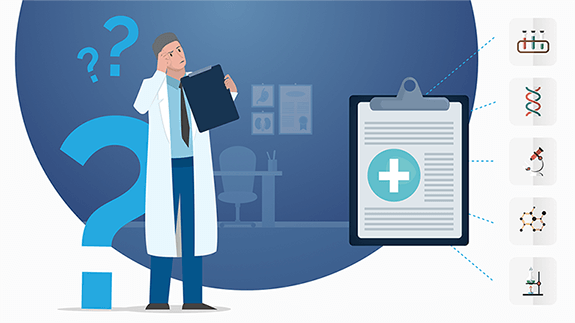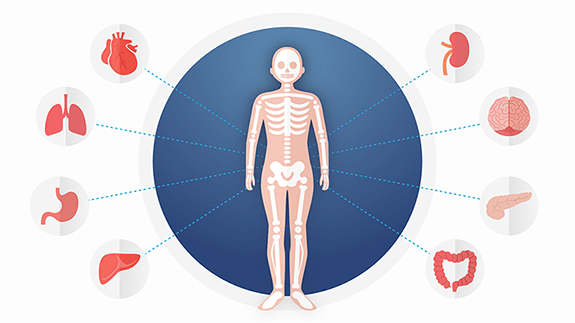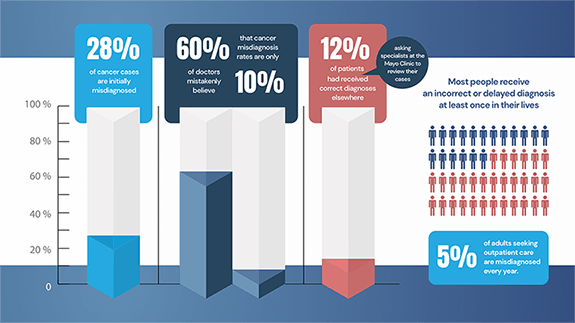Getting a diagnosis of cancer is often overwhelming, as well as frightening. Not only do we fear impending mortality, but also the harsh treatments we may have to endure to survive. Perhaps the only thing worse than a diagnosis of cancer is a misdiagnosis of cancer – meaning a failure to timely diagnose cancer. Cancer misdiagnosis can have a serious negative impact on the course of our lives. At Cummings Law, located in Nashville, we believe strongly that cancer misdiagnosis that results from negligence is an intolerable form of medical malpractice for which those responsible must be held liable.

Getting a diagnosis of cancer is often overwhelming, as well as frightening. Not only do we fear impending mortality, but also the harsh treatments we may have to endure to survive. Perhaps the only thing worse than a diagnosis of cancer is a misdiagnosis of cancer – meaning a failure to timely diagnose cancer. Cancer misdiagnosis can have a serious negative impact on the course of our lives. At Cummings Law, located in Nashville, we believe strongly that cancer misdiagnosis that results from negligence is an intolerable form of medical malpractice for which those responsible must be held liable.

Brian Cummings, our lead attorney, is Board Certified in Medical Malpractice by the Ameican Board of Professional Liability Attorneys. He is an outstanding personal injury attorney with excellent credentials and a track record of success. If you or someone you love has suffered serious consequences as a result of a cancer misdiagnosis, come to Cummings Law and Brian will level the playing field between you and the high-power insurance company and medical defense attorneys you will probably be facing. He is deeply committed to protecting your rights and to seeing that you receive the substantial damages you deserve.
Defining Cancer
Cancer is an abnormal, uncontrolled growth of cells which, in some cases, can metastasize (spread) to other parts of the body through the bloodstream or lymphatic system. There are a great many diseases that fall under the cancer umbrella – some are almost benign and involve very little risk, while others are extremely deadly. For this reason, while occasionally a cancer misdiagnosis can be relatively inconsequential, often a mistaken diagnosis due to inattention or failure to recheck test results can be a matter of life or death.
Signs and Symptoms of Cancer
Because cancer can occur in any tissue of the body, its symptoms can vary. Some examples, like the lesions of skin cancer, are usually quite visible, unless they are covered by hair. Some cancers are made apparent through pain or difficulty with digestion, neurological or muscular function, bone pain or fracture, sensory or cognitive impairment, or even fever.

While some cancer manifestations may appear early enough in the disease process that timely diagnosis and treatment may provide a good outcome, by the time others reveal themselves there is little or no hope of survival. To make all of this more complicated and confusing, certain parts of the body, such as the breast, may be attacked by various types of cancer — some easy to treat and some so aggressive that even cutting-edge procedures can be less likely to provide a good outcome.
Common Tests for Diagnosing Cancer
Modern medicine has developed many diagnostic tests to find cancer cells as early as possible. Most are performed on both men and women, but a few, such as PAP smears for women and prostate exams for men, are gender-specific. Most people go through cancer screenings at times in their lives. Some screenings are done as part of regular medical protocol for individuals of certain ages. Other testing is administered only if a patient is symptomatic or at high risk for the disease.
Tests for the General Public
Because the following diagnostic tests have proven very helpful in lowering mortality rates for specific types of cancer they target, they are generally recommended:
- Complete blood count (CBC) — starting at an early age as part of a regular check-up
- Mammography — starting at age 45 to 50, or even earlier if there are certain risk factors present
- Colonoscopy — starting at 50 (unless an immediate family member developed colon cancer at an early age) and continuing until age 75
- Digital rectal exam — starting at age 50 for men (prostate) and women (ovaries and uterus)
- Electrocardiogram (EKG) — starting at age 45 unless there are symptoms or risk factors
- Fecal occult blood test — at times instead of, or in addition to, a colonoscopy
- Pap smear — from age 21 to age 65
- Prostate-specific antigen (PSA) test starting at 50 unless patient is at high risk

You should be aware that not all doctors agree about when these tests should begin being taken and when they are unnecessary. Much depends on your particular risk factors due to your lifestyle and heredity. If you have symptoms or one of the above tests comes back with abnormal results, you may need to follow up with one of the following:
- X-ray to show images of bones
- Barium enema to examine the colon and rectum
- Biopsy of skin, muscle, bone, or organ tissue to determine the presence of cancer cells (biopsies can be taken from a skin lesion, during a needle biopsy or surgical procedure)
- Bone marrow aspiration and biopsy
- Ultrasound, commonly of breast of heart
- Computed Tomography (CT) scan to detect joint and muscle problems
- Endoscopy to examine the upper digestive tract
- Bronchoscopy to examine the inside of the lungs
- Magnetic Resonance Imaging (MRI) scan to show soft tissues, such as tumors
- Positron Emission Tomography and Computed Tomography (PET-CT) Scans used to find cancer throughout the body and learn its stage
- Sigmoidoscopy to examine the lower part of the colon

Common Reasons for a Cancer Misdiagnosis
Though everyone makes mistakes and not all mistakes made by healthcare professionals constitute medical malpractice, when a cancer misdiagnosis occurs a serious investigation is in order. That type of mistake can be fatal to a patient. Doctors and others in the medical field are held to a higher standard of care than the average person since a medical mistake can have dire consequences, and they have plenty of tests available to them to workup and diagnose cancer. Because those who work in healthcare are aware of the depth of their responsibility, they must take test results very seriously and examine them very closely. Therefore, if a mistaken cancer diagnosis is made, someone may have been negligent in one of the following ways:
- Failed to perform thorough physical examination
- Failed to recommend or offer cancer screening
- Failed to recommend necessary tests
- Failed to take a biopsy
- Failed to refer patient to an appropriate specialist
- Misinterpreted symptoms
- Ignored or dismissed symptoms
- Made a mistaken evaluation of test results
- Improperly administered tests
- Misunderstood or miscommunicated medical data
Tragically, because of the multiple types of cancer and the complexity of diagnosis, cancer is one of the diseases most commonly misdiagnosed. Also, many patients do not exhibit symptoms of cancer until their condition has reached an advanced stage.
For this reason, doctors and patients should always be on the alert and be aware that the most obvious diagnosis may not be the right one. Failing to follow up an original diagnosis and pursue every possible underlying cause may be considered medical negligence. This is particularly true if treatment based on the original diagnosis is not working as expected.

Types of Cancer Most Frequently Misdiagnosed
Although any kind of cancer can be misdiagnosed, among those commonly diagnosed are lymphoma, sarcomas and melanomas as well as those listed below:
Breast Cancer Misdiagnosis
Even though breast cancer is a relatively common type of cancer estimated to affect one in eight women, there are many cases in which the disease is misdiagnosed. For one thing, many women have cystic breasts so it is not all that unusual for a cancer to be misperceived as a harmless cyst by a non-attentive physician. Another problem is that inflammatory breast cancer, unlike other types of the disease, presents as red, inflamed tissue that is warm to the touch. This physical evidence mimics mastitis, a condition not uncommon in nursing mothers that can also occur in non-lactating women or in men.
Colorectal Cancer Misdiagnosis
One of the reasons colorectal cancer is misdiagnosed is that digestive symptoms are a relatively common ailment. In some cases, these symptoms are traceable to food allergies, reactions to medications and fairly simple conditions like chronic constipation, intermittent diarrhea, or hemorrhoids. In others, serious underlying causes such as irritable bowel syndrome (IBS), Crohn’s disease, or ulcerative colitis are responsible for the symptoms. Any of these digestive conditions, however, may mask colorectal cancer or accompany it, leading to serious misdiagnosis of a potentially fatal disease.
Pancreatic Cancer Misdiagnosis
Pancreatic cancer has become a scourge in recent decades. Its symptoms often show up so late in the progression of the disease that there is very little to be done to provide a good outcome. Unless the proper diagnostic imaging tests are administered early, pancreatic cancer may initially be misdiagnosed as IBS, gallstones, pancreatitis, or even diabetes. Because pancreatic cancer can progress very quickly, even a short period of delayed treatment can result in a significantly increased risk of rapid mortality. It has been estimated that pancreatic cancer is initially misdiagnosed in approximately 30 percent of cases.
Lung Cancer Misdiagnosis
Because respiratory symptoms are so common, especially in individuals who are long-term smokers and/or asthmatics, the following symptoms of lung cancer may, at least for some period of time, be misdiagnosed:
- Coughing
- Shortness of breath
- Wheezing
- Hoarseness
Doctors may be negligent for failing to test for lung cancer when patients present with these symptoms because these patients are known to have asthma, pneumonia, tuberculosis, bronchitis, or even pleurisy and the doctor does not effectively consider the possibility of cancer. Because it is possible for a patient to have one of these conditions but lung cancer as well, a doctor who doesn’t rule out cancer as a cause may be considered negligent in a court of law.
Ovarian Cancer Misdiagnosis
The symptoms of ovarian cancer — severe pelvic pain, diarrhea, constipation, infertility, and irregular menstrual bleeding — are nearly identical to the symptoms of endometriosis. Treating for endometriosis without investigating further may allow a potentially deadly malignancy to advance and grow, which leads to a worse outcome when it is later diagnosed.

Statistics Regarding Cancer Misdiagnosis
Shockingly, one of the world’s oldest peer-reviewed general medical journals, BMJ Quality & Safety, estimates that 28 percent of cancer cases are initially misdiagnosed. Perhaps even more troubling, researchers at Best Doctors Inc. and the National Coalition on Health Care (NCHC) have discovered that approximately 60 percent of doctors mistakenly believe that cancer misdiagnosis rates are only 0 to 10 percent.
Only 12 percent of patients asking specialists at the Mayo Clinic to review their cases had received correct diagnoses elsewhere. To put this data in context, a 2015 report by the National Academy of Medicine states that most people receive an incorrect or delayed diagnosis at least once in their lives and that 5 percent of adults seeking outpatient care are misdiagnosed every year.

Demographics in Terms of Misdiagnosis
Depending on your age, gender, or race, you can find yourself at a greater risk of cancer misdiagnosis. Studies have found that young adults (under the age of 50) more frequently have colorectal cancers that are not diagnosed, mostly because doctors do not prescribe screenings for them no matter what their symptoms.
Women generally are misdiagnosed at a higher rate than men. A 2016 Journal of Clinical Oncology study found that black women, regardless of their risk level, are less likely than white women to undergo genetic testing, in large part because their physicians are less likely to recommend it.
Lawsuits Against Hospitals for Misdiagnosis
In some cases of cancer misdiagnosis, it is possible to sue hospitals, as well as, or instead of, doctors, including radiologists, pathologists, surgeons if, for example:
- Administrators never properly vetted the doctor in charge
- An employee of the hospital (typically a nurse or technician rather than a doctor) made an egregious error resulting in misdiagnosis
- Hospital protocol was not established or followed in terms of testing procedures or interdepartmental communication
Unfortunately, Tennessee has been named the fifth-highest offender in the country in terms of malpractice cases by Becker’s Hospital Review. In addition, Vanderbilt University Medical Center, known as Nashville’s primary hospital, has faced at least two major malpractice claims during the past several years, one resulting in a $2 million verdict for the plaintiff.

Legal Options Regarding Cancer Misdiagnosis
If you or a loved one suffered the trauma of a cancer misdiagnosis that has altered your life in a negative way or has tragically shortened your life, Cummings Law is here to help you find justice. If your misdiagnosis was due to negligence on the part of a healthcare professional or facility, you and your family are entitled to substantial compensation for your physical pain, mental anguish, lost income, disfigurement (e.g. an unnecessary mastectomy), long-term disability, loss of consortium (loss of relationship with a loved one), lost quality of life, and shortened life expectancy. It is also possible for us to file a wrongful death lawsuit after a loved one has died as a result of a failure to timely diagnose cancer. Contact Cummings Law to get the help you and your family need.
